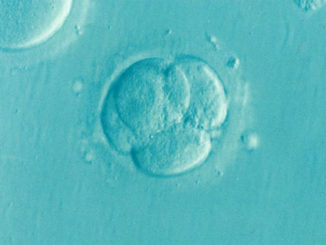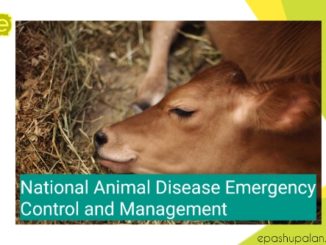Per-rectal palpitation is most conventional, cost effective, accurate and practical method of examinations for the following conditions:
- Diagnosis of pregnancy, estimation of gestational age of the conceptus and characterization of physiological/ pathological reproductive status.
- Assessment of current reproductive status and to predict important reproductive events to come such as estrus, ovulation, parturition or abortion.
- Rational approach to therapy and for establishing a prognosis for conditions of uterus, fallopian tube, ovaries and supporting structures (Bursa).
Principles of Per-rectal examination
- Prior to rectal examination, the complete breeding history and reproductive records of the animal should be studied, if available.
- The animal should be well secured in Trevis/crush to assure the safety of both patient and examiner.
How to Avoid Rectal wall bleeding
- Animal should be properly restrained by putting in a Tervis if not available restrain against tree.
- The finger nails are closely trimmed and the tips are smoothened.
- Good lubrication of gloved hand with glycerinated soap (Carbolic soap, washing soaps should be avoided, as such soaps cause more irritation, to the skin in the long run of usage-predisposes for fungal infection). Liquid paraffin or dung can be used if others are not available immediately.
- Ballooned rectal wall will result in greater diameter of rectal wall due to stretching, so it will be difficult to grasp the genitalia. It can be made to overcome easily by:
-
- Tapping repeatedly the dorsal wall of rectum, the part below the sacrum from anterior to posterior direction will leads to expulsion of air by peristalsis due to reflex stimulation.
- Insert the hand forward and first peristaltic ring is gently grasped and pulled back wards.
- Cold water enema.
- If rectum is dry-cold water enema is advised.
- Inspite of gentle handling of rectal wall and genitalia, too much force from fingers on rectal wall do cause bleeding, and occasionally the rectal wall may tear.
Note: When the animal sends a peristaltic wave of rectal wall, the fingers are stretched into and cone shape till the peristalsis passes off to avoid damage.
After proper restraining the animal and lubricating the hand the base of the tail is held with the un-lubricated hand and pulled towards the clinician and the tail is slightly raised to facilitate the introduction of one finger (commonly fore finger) into the rectal sphincters’ and then all fingers and wrist. Generally buffaloes do not allow such examination but once the hand is introduced into the rectum up till the wrist, they will keep quite.
Precautions
- The examiner has to stand by the side of the animal, otherwise when air is expelled along with the dung it is sprayed on the clothes of the examiner or on the faces of persons behind the animal.
- The hand should not be rotated while introduced into the rectum.
- Cervix is the landmark for all rectal examinations of Bovine female genitalia because of its distinct characteristics and relatively constant position.
Location and Examination of Cervix
- The arm is inserted for enough to palpate the pelvic inlet.
- The hand with the fingers slightly bent is swept along one of the walls of the pelvic cavity down to the floor and over to the other side.
- If cervix is not located in the first sweep, the process is repeated at different depths until it is found.
- The cervix is recognized as a firm cylindrical and somewhat nodular structure lying on the midline of the pelvic floor.
- In Non pregnant/early pregnant cows the cervix is mostly located in the midline of pelvic cavity with the whole uterus within the pelvic cavity.
- In Non pregnant buffalo it is more posterior in location.
- In exotic & older animals and in pregnant animals the cervix may be located over the pelvic brim.
Size of Cervix
- Varies with age, stage of reproductive cycle & presence or absence of abnormalities.
- Length is about 7.5 to 10 cm. and width is about 2.0 to 6.00 cm
- Slightly tapers off towards the internal os.
- Size increases with age, parity and disease status.
- Enlargement is more prominent in the posterior end.
- In pregnant cows it does not enlarge before relaxation. Edema becomes prominent early in the first stage of labor.
Position/Location of Cervix
- In non pregnant and early pregnancy (up to 90 days) mostly within pelvic cavity.
- A full urinary bladder may displace it sideways.
- In older animals and in certain exotic breeds may be at pelvic brim or abdomen.
- Late pregnancy-over pelvic brim or abdominal.
Mobility of Cervix
- The cervix is freely mobile in non pregnant and early pregnant animal’s up to 60-70 days.
- It is immobile and fixed by the weight of the uterus in late pregnancy and also by the involuting uterus up to 10-14 days post partum.
- Cervix may also be fixed in pathological conditions like pyometra, mucometra, hydrometra, tumors or adhesions.
Examination of the uterus
Always one uterine horn is palpated from base to its tip (ovarian end), and palpated back in the same reverse direction, then the opposite horn is palpated from its base to the tip and palpation is continued in reverse direction.
How to palpate the uterus?
Passing the fingers into dorsal inter-cornual ligament and palpating the uterus by lifting one of the horn and then the other horn is now an out dated method as it can cause rupture at the intercornual ligament. Hence the hand is passed fast at the entrance of the pelvis and down into the abdominal cavity and the hand is half clinched (like a scoop) and is withdrawn it in this position as far the pelvic brim. This scooping of uterus can be done with non pregnant and early pregnant uterus, or the hand is passed suddenly under the cervix, so the uterus is palpated dorsally including horns by inserting fingers and thumb around each horn or hand and fingers are passed around the horn along with the broad ligament folded back and the horn is examined from its base to tip and from tip to its base. Observations has to be made for the size, symmetry, of horns, shape or tubularity (one has to estimate this on the basis of cross section of uterine horn at its base- an imaginary method arrived by examining per rectally) Consistency, tone or Contractility and presence of any Contents.
Examination of the Ovaries
Ovaries should be routinely examined in all animal found to be non pregnant. Palpation of ovaries is contra-indicated in pregnant animals except in very early pregnancy, because it gives no useful information and if the corpus luteum is damaged pregnancy will be lost.
- The ovaries are usually located on the pelvic floor about 3 cm lateral to the cervix and usually about 3 cm cranial to internal os.
- The ovaries may also be traced from the tip of uterine horns slightly posterior and lateral to them.
- Another method of locating ovary is by hooking the anterior border of the broad ligament with bent fingers and tracing it along its anterior border.
- Once the ovary is located it is lifted up and held between the two middle fingers and the surface is palpated with the thumb.
- Ovarian stroma with the exception of functional corpora lutea and follicles is firm and nodular.
- Observe for position, size, surface (smooth/ rough), consistency (smooth or lumpy portions or cavities) as well as for fluctuations (follicle/s cyst/s ) or corpus luteum. Record their size and location. The follicle may be one, few or many.
- Position in the pelvic cavity (non pregnant and in early pregnancy especially in heifers); the abdominal cavity (pathological conditions or pathology of pregnancy such as Mummified fetus, macerated fetus, hydropsy conditions)
- Irrespective of the length of the ovaries and their height/width, the thickness of the ovary is measured and if the CL is more than 50% of the thickness of the ovary it is called as functional (having projection elevated with central depression), if its diameter is between 25 to 50% of the thickness of the ovary, the CL is regressing (having projection which is narrow or conical and firm); and if CL is smaller than 25% of the thickness of the ovary it is considered as a regressed CL. If the C.L, is soft it is considered as developing CL while if it is firm it is a developed CL.
Persistent corpus luteum
When the CL is of same size, shape, located on the same place in the same ovary when repeated examination are made 7 to 10 days apart. PCL is seen only in pseudo pregnancy/ early embryonic death, pyometra mummification, maceration while in pregnancy its size increases.
Reference
- Veterinary Reproduction and Obstetrics Tenth edition(2019) . David E. Noakes, Timothy J. Parkinson and Gary C. W. England
- Diagnosis and Treatment of Reproductive Disorders in Dairy Cows(Theriogenology-I) First edition (1994) Dr. V. N. Viswanatha Reddy






1 Trackback / Pingback